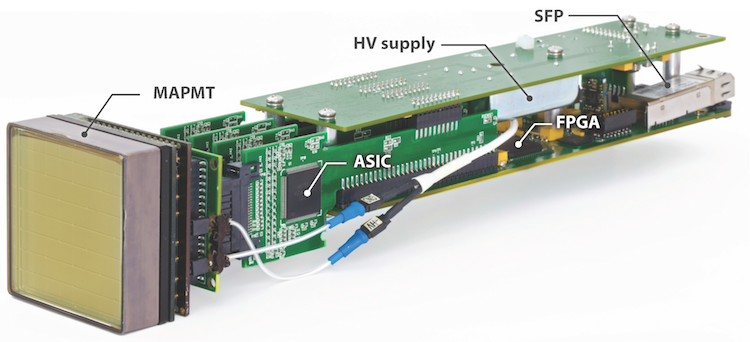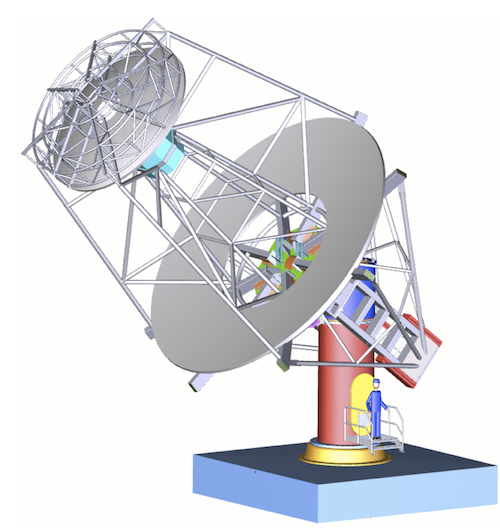During the last couple of decades, ground- and satellite-based detectors have enabled a new view of the universe built on increasingly high energy gamma rays. Now, the international gamma-ray community is getting ready for the next challenge: the Cherenkov Telescope Array (CTA).
CTA will detect gamma rays with unprecedented precision. To do this, physicists have designed not only new telescope optics and cameras but also the required front-end electronics, including a new multichannel digitizer, dubbed TARGET.
At WIPAC, a team led by Justin Vandenbroucke is working on camera modules (consisting of single-photon detectors and readout electronics) for dual-mirror CTA telescopes. The modules will be featured in two different telescope designs.

CTA will be an array with dozens of telescopes of three different sizes, located at two sites in order to view both hemispheres: Chile and the Canary Islands in Spain. Once fully deployed, CTA will detect gamma rays from 30 GeV up to 300 TeV. At these energies, gamma rays entering the atmosphere produce a shower of subatomic particles, each showing up in dark skies as a brief flash of blue light.
The first generation of TARGET chips indicated that dual-mirror Cherenkov telescopes with compact, high-resolution cameras could be built with high performance and low cost, making it feasible to deploy a large number of such telescopes. The new version of this chip, called TARGET 5, advances the design towards final performance requirements for CTA.
TARGET electronics are a key component in two different telescope designs currently in the prototype phase. A prototype Schwarzschild Couder Telescope (SCT), featuring a 9.5 meter primary mirror, is under construction in Arizona (for a webcam viewing the construction, click here). This medium-sized telescope will cover the core energy range of CTA. A smaller prototype Gamma-ray Cherenkov Telescope (GCT, focusing on the highest energy gamma rays) has been constructed in France. TARGET 5 modules on the telescope successfully recorded air showers there several months ago, the first time air showers have been imaged by a prototype CTA telescope.

Both the SCT and GCT telescope designs use arrays of TARGET modules. Each module consists of 64 pixels that monitor the night sky, watching for the gamma-ray induced faint Cherenkov flashes that for a few nanoseconds will light up the sky, illuminating thousands of square meters of the array. At a much higher rate, the telescope will also record Cherenkov light produced by the interaction of background cosmic rays in the atmosphere.
TARGET chips were designed to match the dual-mirror telescope optics in order to obtain improved resolution with a smaller camera and still a wide field of view. They provide signal sampling and digitization, as well as triggering, for 16 channels in each chip. The TARGET electronics enable the use of compact and densely pixelated silicon photodetectors in order to improve angular resolution and background rejection capabilities.
The chip can capture the nanosecond Cherenkov pulses by sampling each pixel one billion times per second. It also provides a deep buffer that will enable trigger algorithms including multiple telescopes.
The new chips feature two-staged sampling operations, which allows a large bandwidth without compromising the buffer size, an increased dynamic range with smaller crosstalk, and better charge resolution.
Another version, TARGET 7, has been developed with further improvements. Camera modules based on TARGET 7 will be installed on the prototype SCT in Arizona.
Vandenbroucke has played a leading role in the development of the SCT camera and the readout electronics, including TARGET, since his time as a postdoc at the Kavli Institute for Particle Astrophysics and Cosmology. His team at UW–Madison is currently testing camera modules for the prototype SCT camera, which will be fully assembled at Chamberlin Hall, the building that hosts the physics department.
Tianyao Wu, one of the team members and a co-author of the TARGET 5 paper, started working on CTA as a UW–Madison undergraduate three years ago. “I originally chose a chemistry major and only thought physics was full of tedious calculations,” says Wu. “Thanks to the research opportunity WIPAC provided, through TARGET 5 characterization, I learned the exciting part of physics—especially astrophysics—and eventually decided to go to graduate school in physics,” adds Wu, who will soon start as a graduate student at Ohio State University.
Stay tuned to learn more about this cutting-edge camera. “It has good optics and high resolution, like your compact digital camera,” says Vandenbroucke. “But unlike your camera, it will detect single photons with nanosecond resolution and weigh several hundred pounds.” To the delight of the Badger community, it comes in a bright red color.
+ info “TARGET 5: a new multi-channel digitizer with triggering capabilities for gamma-ray atmospheric Cherenkov telescopes,” A. Albert, S. Funk, T. Kawashima, M. Murphy, A. Okumura, R. Quagliani, L. Sapozhnikov, H. Tajima, L. Tibaldo, J. Vandenbroucke, T. Wu, Astroparticle Physics 92 (2017) 49, sciencedirect.com, arxiv.org/abs/1607.02443
+ info “CTA Prototype Telescope Achieves First Light”, CTA press release, December 8, 2015 (pdf)
